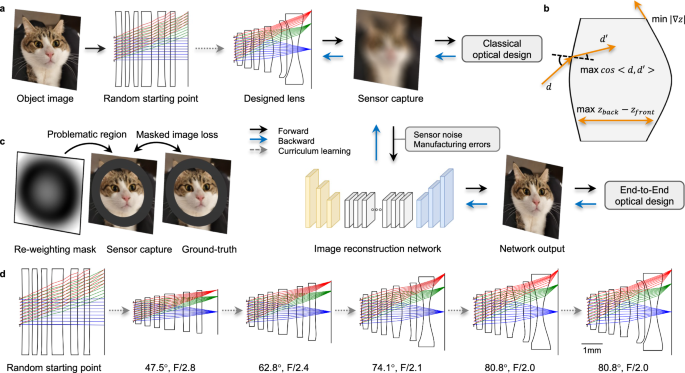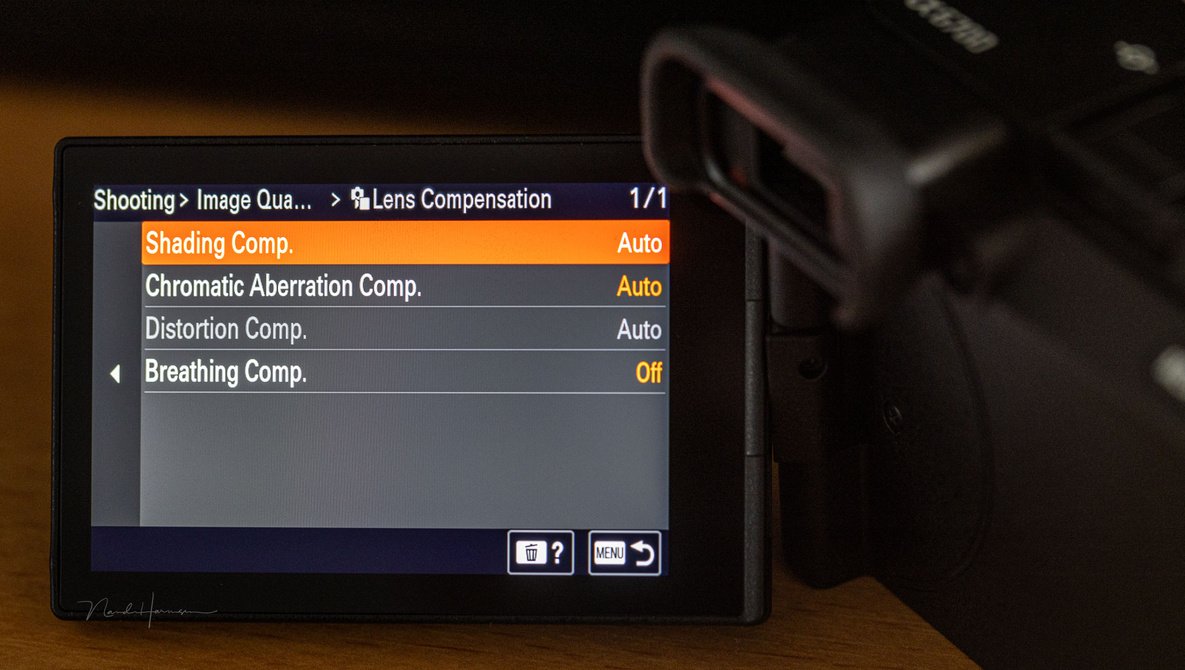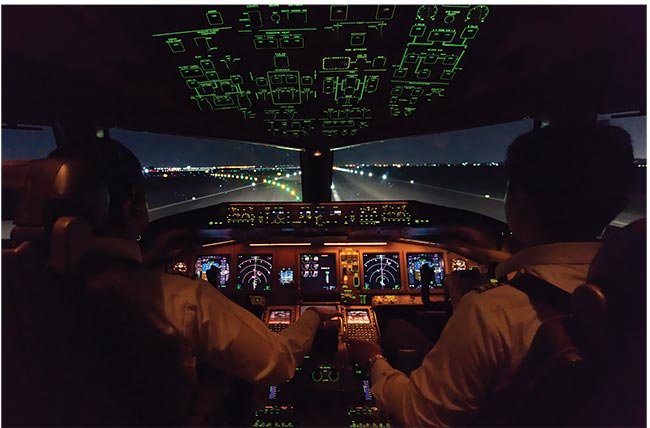Due to access restrictions, we are unable to retrieve the content from the requested Business Wire article regarding EXATEL’s customized Software-Defined Optical Networking Platform with IP Infusion OcNOS®. Attempts to access the page resulted in an “Access Denied” error message, indicating a permission issue on the server.
Author: raoam488
-

AI Designs Advanced Lenses From Physics with Curriculum Learning
Researchers have developed a novel automated lens design method using a technique called curriculum learning, addressing challenges in creating complex imaging lenses. The new framework leverages differentiable ray tracing to simulate how camera images are captured and to fine-tune lens parameters. This approach tackles issues like flawed lens shapes and designs that get stuck in suboptimal configurations during the optimization process.
The curriculum learning strategy breaks down the complex lens design into a series of simpler steps, gradually increasing the difficulty. This mimics how students learn, starting with easier concepts and progressing to more complex ones. Key elements of this strategy include a gradual increase in design difficulty, optical regularization to prevent unwanted lens shapes, and a dynamic re-weighting mask to guide the design process away from poor solutions.
In experiments, this curriculum learning method successfully designed high-performance lenses, even starting from basic, almost flat lens shapes. It proved effective in creating lenses with wide fields of view and large apertures, specifications that are typically challenging to achieve through automated design. The method was shown to overcome limitations of previous approaches, which often failed to produce functional lenses under similar design demands.
Furthermore, scientists demonstrated the versatility of this curriculum learning approach by designing an extended depth-of-field (EDoF) lens for computational cameras. These specialized lenses, combined with computational image processing, allow for sharp images even when objects are at varying distances. The innovative lens design incorporates a hybrid surface that blends conventional aspheric shapes with unique polynomial elements to control image blur in a way that facilitates computational correction.
The EDoF lens was paired with an image reconstruction neural network to sharpen images captured by the lens. Testing showed that this integrated system produced consistently clear images across a wide range of distances, from very close objects to far-away scenes. Compared to traditional lenses, and even EDoF lenses using simpler designs, this new lens and computational approach delivered superior image quality and depth-of-field performance. The research highlights the potential for this automated lens design method to create advanced optical systems for diverse imaging applications.
-

Here are a few options for your news article title, all under 13 words:
- Viral Circular Tube Map Contains Surprising Optical Illusion (9 words)
- Optical Illusion Spotted in Viral Circular Tube Map! (8 words)
- Surprise! Viral Tube Map Hides Clever Optical Illusion. (9 words)
- Mind-Bending Illusion Found in Viral Circular Tube Map. (9 words)
- Internet Stunned by Optical Illusion in Viral Tube Map. (10 words)
A redesigned London Underground map, reimagined in a circular format by cartographer Max Roberts, is gaining renewed attention online. This updated version of Roberts’ design, which initially went viral several years ago, aims to offer a less cluttered and more geographically accurate representation of the Tube network compared to the iconic official map, originally designed by Harry Beck in 1933.
Roberts’ circular map arranges the traditional coloured Tube lines as spokes radiating from the centre, aiming for improved readability and geographical precision. While not the first to explore a circular Tube map – Roberts cites Jonny Fisher’s 2013 design as initial inspiration – and following Transport for London’s recent use of circular maps in a Samsung promotional campaign on the Circle Line, Roberts refined his 2013 version, correcting errors using older software.
According to Roberts, the resemblance of the Circle Line to the Tube logo in his design is coincidental, arising naturally from the line’s actual shape. While a departure from the established map, Roberts draws parallels to the initial reception of Harry Beck’s revolutionary design in the 1930s. Posters of Max Roberts’ map designs are available for purchase online.
-

Robotic Vision Market Expands: Latest Report Details Size, Share & Growth.
Robotic Vision Market Expected to Reach USD 4.0 Billion by 2028, Driven by Automation and 3D Vision Advancements
[City, Date – September 12, 2024] – The Robotic Vision market is poised for significant expansion, projected to grow from USD 2.6 billion in 2023 to USD 4.0 billion by 2028, according to a new report. This represents a compound annual growth rate (CAGR) of 9.1%.
The increasing demand for automation across industries, coupled with the advanced capabilities of 3D vision systems, are cited as major factors propelling this market growth. 3D vision technology is enabling robots to perform a wider range of tasks without requiring extensive reprogramming, making them more versatile and efficient.
Smart Cameras Fueling Growth
A key driver identified in the report is the rising adoption of smart cameras in robotic vision systems. These compact and easily programmable cameras offer a compelling alternative to more complex PC-based systems. Smart cameras provide robust processing power and are increasingly incorporating features like embedded systems, MIPI interfaces, image pre-processing, and onboard FPGAs. Their integrated nature, including storage, digital I/O, and industrial communication interfaces, simplifies integration and programming, often at a lower cost compared to PC-based alternatives. Industries with challenging environments, such as those with messy or dusty workspaces, are particularly well-suited for smart camera implementation. Pharmaceutical and food & beverage sectors are early adopters of this technology.
Awareness and Skilled Workforce Remain Challenges
Despite the strong growth forecast, the report highlights some restraints. Limited awareness of robotic vision systems, especially in developing countries, is hindering wider adoption. In regions like India, industrial robots and advanced vision systems are primarily used in larger industries like automotive and metals, with less penetration in smaller sectors. The need to educate end-users about the benefits of robotic vision is crucial. Furthermore, a shortage of skilled professionals capable of programming and managing these vision systems poses a challenge, particularly in developing countries and even in North America and Europe.
Customization Opportunities and Complex Programming Challenges
The increasing demand for robotic vision is also driving a trend towards greater customization. Industries like automotive assembly, food packaging, medical device manufacturing, and pharmaceuticals are seeking tailored robotic vision solutions to meet stringent quality demands. Collaborative robots and customizable vision sensors are gaining traction as manufacturers seek flexible automation platforms.
However, programming complex inspection tasks remains a significant challenge. Traditional robotic vision systems rely on rule-based algorithms that can struggle with unpredictable defects or variations. Identifying cosmetic anomalies and dealing with factors like lighting and surface textures can be difficult. The food & beverage industry, for example, faces challenges in using vision systems to consistently identify defects in natural products like potatoes. The development of AI-based software solutions is anticipated to address some of these more complex inspection challenges in the future.
Market Ecosystem and Regional Growth
The report indicates that the 3D vision systems segment is expected to experience the highest CAGR during the forecast period (2023-2028) due to advancements in technology, increased accuracy, and broader applications in various industries. Similarly, the software segment is also projected for high growth, driven by the integration of Artificial Intelligence (AI) in robotic vision software, particularly deep learning, which enhances object recognition capabilities. The food & beverages industry is expected to be the fastest-growing sector in terms of adoption of robotic vision.
Regionally, Asia Pacific is identified as the largest and fastest-growing market for robotic vision, fueled by its position as a major manufacturing hub and the rapid economic growth of countries like China, Japan, and South Korea.
Key Market Players
Major companies in the Robotic Vision market include Cognex Corporation (US), Basler AG (Germany), OMRON Corporation (Japan), National Instruments Corporation (US), Keyence Corporation (Japan), Teledyne DALSA (Canada), Sick AG (Germany), Torvidel AS (Norway), Hexagon AB (Sweden), Advantech (Taiwan), Yaskawa America, Inc. (Japan), ISRA VISION (Germany), FANUC CORPORATION (Japan), ABB (Switzerland), and Qualcomm Incorporated (US). These companies are actively pursuing strategies like product launches, collaborations, and acquisitions to strengthen their market position.
Recent Industry Developments
Recent activity in the market includes Cognex Corporation’s launch of the Advantage 182 vision system in May 2023, designed for complex identification, classification, and inspection tasks, and the In-Sight 3800 Vision System in April 2023, aimed at high-speed production lines. Teledyne DALSA also released Sapera Vision Software Edition 2023-03 in March 2023, featuring updates to its AI training and image processing tools.
-

Here are a few options for news article titles based on "Will Modern Lenses Have an Increased Dependence on Lens Corrections?" keeping it under 13 words:
- Modern Lenses: Increasingly Reliant on Software Corrections? (8 words)
- New Lenses Show Growing Dependence on Digital Fixes. (9 words)
- Lens Correction Dependence: The Future of Modern Optics? (9 words)
- Software Fixes: Are Modern Lenses Now More Dependent? (9 words)
- Modern Lenses: Greater Need for Software-Based Correction. (9 words)
Lens manufacturers are increasingly releasing new lenses that depend on software for image correction, raising questions about potential shortcuts in lens design. While lens correction can address issues like distortion and vignetting, some photographers are concerned about the growing reliance on it.
Historically, lens distortion was an expected characteristic, particularly in specialized lenses like fisheyes. Correcting this distortion through software was possible but could degrade image quality, especially at the edges. Modern lens design has made significant progress in minimizing optical flaws. Lens makers have strived for near-perfect images through complex designs and innovations in coatings and lens elements.
However, a recent trend indicates a shift towards lenses designed with the expectation of software correction. Several new lenses from brands like Sony and Canon exhibit noticeable distortion and vignetting that are intended to be corrected in-camera or through software processing. Examples include the Sony FE 20-70mm f/4 G, FE 16-25mm f/2.8 G, and FE 24-50mm f/2.8 G, as well as the Canon RF 10-20mm f/4L and the recent RF 24mm f/1.4L VCM, RF 35mm f/1.4L VCM, and RF 50mm f/1.4L VCM lenses. In some cases, these corrections are baked into the raw files themselves.
While software correction can deliver acceptable image quality in many situations, it presents challenges for certain photographic techniques. Image stacking, for instance, can suffer from banding artifacts due to the unique correction applied to each image. Techniques like focus stacking might also be affected. Furthermore, correcting vignetting can amplify noise, especially at high ISO settings, and distortion correction by stretching images may lead to a subtle loss of detail.
Despite these drawbacks, lenses designed for software correction offer benefits. Simplified optical designs can result in smaller, lighter, and potentially more affordable lenses. The Canon VCM series and Sony’s recent G series lenses are examples of this compact design philosophy. These smaller lenses are appealing for portability.
However, for photographers who require uncorrected images or prefer lenses with minimal inherent distortion, this trend might be concerning. The concern is that manufacturers may prioritize software-dependent designs, potentially limiting the availability of lenses that achieve high image quality purely through optical design. The shift prompts a debate about the balance between software correction and optical excellence in modern lens development and whether the pursuit of smaller, lighter lenses is overshadowing the desire for optimal optical performance from the outset.
-

Nokia Acquires Infinera, Expanding Its Network Solutions Portfolio
Nokia has completed its acquisition of Infinera, marking a significant step in establishing Nokia as a leading force in optical networking. The integration of Infinera’s portfolio is expected to enhance Nokia’s offerings, creating a broader and deeper range of solutions for customers. Nokia anticipates that the combined expertise and product development capabilities will accelerate innovation and deliver differentiated solutions more rapidly. The acquisition aims to position Nokia to address the increasing demands for optical solutions driven by technological shifts, particularly in areas like edge-to-core capacity expansion and power efficiency. The company highlights this as a new era of Nokia Optical innovation, promising hyperscaled opportunities for its customers. For further details on the acquisition, interested parties are directed to the full news story available on Nokia’s website. Support and information related to Infinera will now be accessible through Nokia channels.
-

Simulation Visualizes Optical Brilliance in Groundbreaking Optical Design
Innovative optical technologies are increasingly being used across industries, from medical devices to manufacturing tools, driving demand for higher-quality, lower-cost optical designs. These advanced technologies, encompassing freeform optics, diffractive optics, and metasurfaces, require meticulous design to ensure performance under all operating conditions. System-level engineering, facilitated by multiscale, multiphysics simulation, is now essential for successful optical and optically enabled product designs.
Miniaturization is a key trend, with optics playing a critical role in creating smaller, lighter, and cheaper products. Cost is also a major consideration, impacting manufacturing, reliability, and performance stability. Advanced technologies like freeform optics, diffractive optics, and metasurfaces are shaping the future of optical design, offering enhanced capabilities, but understanding and harnessing their potential requires sophisticated simulation.
Simulation allows engineers to virtually test designs under various conditions, identifying weaknesses and optimizing performance before physical prototypes are built. This is crucial for achieving desired performance and reliability, especially with advanced technologies. Multiscale simulation is needed to model optical systems ranging from microscopic to macroscopic components, while multiphysics simulation is vital for understanding how optics perform within products, considering factors like manufacturing variations, thermal loads, and mechanical stresses.
Various simulation techniques are employed. Geometric ray tracing remains reliable for macroscopic components, while wave effects are considered using methods like Fourier propagation. Electromagnetic simulation, using techniques like FDTD and FEM, becomes necessary at smaller scales. For periodic structures such as diffractive optics and metasurfaces, rigorous coupled wave analysis (RCWA) offers efficiency.
Companies like Ansys, Synopsys, Lambda Research, and Photon Engineering provide commercial simulation tools. Cloud-based simulation platforms are also emerging, promising to accelerate the design process by enabling distributed computing for complex multiscale, multiphysics simulations.
In medical diagnostics, miniaturization drives the use of metalenses in endoscopes for improved performance. Simulation workflows for metalens-based endoscopes involve geometric ray tracing and electromagnetic simulation, ensuring design validation and manufacturability. Aerospace and defense sectors also heavily rely on multiscale, multiphysics simulation for mission-critical optical systems operating under extreme conditions. For instance, designing optical sensors for high-speed aircraft requires considering turbulence, heating, and their impact on sensor performance. Simulation workflows for aerospace applications combine geometric ray tracing, CAD, computational fluid dynamics (CFD), and finite element analysis (FEA) to optimize designs and account for environmental factors.
Advancements in computing and the rise of cloud computing are expanding simulation capabilities, enabling faster design iterations and deeper insights. Machine learning and artificial intelligence are expected to further enhance simulation, potentially guiding engineers towards innovative optical solutions and improving design processes. Powerful simulation tools are empowering engineers to push the boundaries of optical design, leading to more efficient, precise, and integrated optical systems for future products.
-
Quasi-Optics Power Complete THz Time-Domain Imaging System
Researchers have developed a complete quasi-optical system designed for Terahertz (THz) time-domain imaging. This advancement in THz technology could lead to improved imaging capabilities in various fields. The system focuses on the manipulation and control of THz radiation using quasi-optical components, potentially offering enhanced performance and efficiency for time-domain imaging applications. This development may have implications for areas that utilize THz imaging, such as security screening, medical diagnostics, and industrial quality control.
-
ScienceDirect Imposes Page Access Restrictions on Certain Pages
ScienceDirect, a leading platform for accessing scientific research, is prompting users to update their web browsers to ensure optimal viewing and functionality. The platform has indicated that using a supported browser version is crucial for correct display and access to its content. Users experiencing issues are directed to a page detailing compatible browsers.
-
Breaking: ‘Just a Moment’ Before Major Announcement Imminent
Visitors to the ScienceX website may encounter a new security protocol. The site is implementing a human verification process where users are required to press and hold a button to confirm they are not automated bots. This measure is reportedly in response to unusual traffic patterns. The website advises users experiencing difficulties to contact their support team.